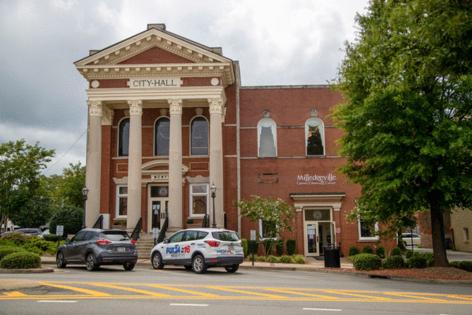How Georgia counties shifted in the 2024 election
Published in Political News
ATLANTA — President-elect Donald Trump’s victory in Georgia played out as a political battle in each of Georgia’s 159 counties, with Trump winning all but 27 of them.
Not only did he win the majority of the statewide vote, in part by making gains in the populous metro Atlanta counties and flipping swing counties, he also succeeded in turning Republican-leaning areas a darker shade of red. Vice President Kamala Harris achieved similar gains in Democratic counties, but she did so in fewer counties and at a lower rate.
The Atlanta Journal-Constitution did a deep dive into county-level results going back through the past five presidential elections to track how we got here. Here’s what we found.
Counties that got redder
Among 129 counties that were already leaning Republican in 2020, 117 moved farther toward the GOP this year — a nearly 2 percentage-point increase on average. But over the last five presidential elections, those 117 counties have shifted almost 7 percentage points to the right, on average.
During former President Barack Obama’s first run in 2008, Chattooga County — above Rome in the northwest corner of the state — went for his opponent, the late Republican Sen. John McCain, with 67% of the vote. In this most recent election, the county voted for Trump with 82% of the vote, giving it the largest Republican increase over the 16-year time period in the state.
In eight counties, Trump gained between 12 to 15 percentage points over McCain’s performance. What do those counties have in common? Each one increased its white voter population, and all but one saw its Black voter population decline.
The growth of the Republican vote in rural Georgia is most often seen alongside a decrease in minority voting strength, and not just in counties that went to Trump. For example, even though Hancock County voted for Harris by almost 68%, that’s down from 2008 when the county supported Obama by about 81%. Over that same period, the Black population has dropped by 20% and the white population has grown by 53%.
While these counties have shifted their Republican voting share the most since 2008, more populous counties are responsible for the largest increases in the raw number of Republican votes. The state’s big, urban counties typically support Democratic candidates, but because of their size and population growth, they account for a lot of Republican voters, too.
The county that has had the greatest increase in Republican voters since 2008 is Cherokee County with almost 42,000 more voters. While Cherokee continues to be a Republican county, its share of Democratic votes has grown from 24% in 2008 to 30% in 2024.
Counties that flipped
This year, three counties — Baldwin, Washington and Jefferson — flipped from voting for President Joe Biden in 2020 to narrow Trump wins. The Republican candidate gained between 1 and 4 percentage points from the last presidential election to cross the 50% threshold.
Brant Kennedy, a Republican who lives in Washington County, said the local GOP worked hard to get to this point.
“We called people. We had phone lists. I’m a pastor, so I had people at church think of 10 people and talk to them about early voting. We saw people came and voted early,” he said. “So it worked.”
Washington County is also ethnically diverse. Black residents make up about 51% of the county’s population and white residents account for 43% of the population, according to the Census’ latest five-year American Community Survey. While Black voters typically support Democrats, white voters in rural areas tend to support Republicans.
Kennedy, the local GOP’s vice chair, said the voters themselves are changing.
“There are Black people here who are seeing that the Democrats are not really the party that’s going to help them, and that the policies that Republicans have proposed are the ones that are really going to help them financially,” he said.
Data found that in Washington County, Black voters showed up at the same rate this year as in 2020, about 44%. White voters also turned out at their same rate, making up about 51% of voters.
Eddie Miller, who is Black and lives in Washington County, said he voted for Trump in this year’s election.
“It’s time we look at politics from a different angle,” he said. “When you’re Black, you get criticized for voting the opposite way. I’ve always been different. I’m going to continue to be different.”
These counties should also be a priority for Democrats, Stephen Lawson, a Republican strategist, told the “Politically Georgia” radio show.
“When you talk about the Black vote, particularly in rural counties, you talk about Baldwin, Washington County, they are not a monolithic voting bloc. They are not just urban areas. We’re talking about rural counties across the state,” he said. “That’s probably where, on the margins, the next election will be decided.”
Counties that got bluer
In the 2016 election, longtime Republican strongholds Cobb and Gwinnett counties flipped for Democrats, joining deep blue DeKalb and Clayton counties. But a few counties south of Atlanta have also seen significant shifts to the left.
Rockdale, Henry and Douglas counties have seen the largest movements toward Democrats since 2008, with a 15 to 19 percentage point increase in vote share for Kamala Harris compared to Barack Obama.
Joyce Broadwater, a real estate agent who lived in Rockdale County for many years and has been involved in Democratic politics, said the racial composition of the county has made it more Democratic.
“If you look at the demographics, there’s more Black people in Rockdale than there used to be,” she said.
The number of Black voters in Rockdale and Douglas counties grew between 76% and 78% from 2008 to 2024. Meanwhile, white voters in Douglas dropped by 20% and in Rockdale by 39%.
These population changes translated to increased vote share for Black voters. In 2024, Black voters made up 19 percentage points more of the vote share in Rockdale and 14 percentage points more in Douglas than they did in 2008. White vote share dropped by 24 percentage points in Rockdale and 20 percentage points in Douglas over the same period.
Broadwater said high-quality subdivisions offering more land for lower prices have attracted many Black families to the county.
“You move outside Atlanta, you get a little bit more for your money,” she said.
Rochelle Howard, a Democrat in Douglas County, said in addition to more Black families moving into the county, she’s also seen more white families leave.
“When we had the Fourth of July parade in Douglasville years ago, you had Blacks on the railroad track right there on that side and we had whites across the street. Now, when you go up there to the parade, it’s all mingled and twisted in and it’s no ‘this side’ and ‘that side’ anymore,” she said.
©2024 The Atlanta Journal-Constitution. Visit at ajc.com. Distributed by Tribune Content Agency, LLC.




























































Comments